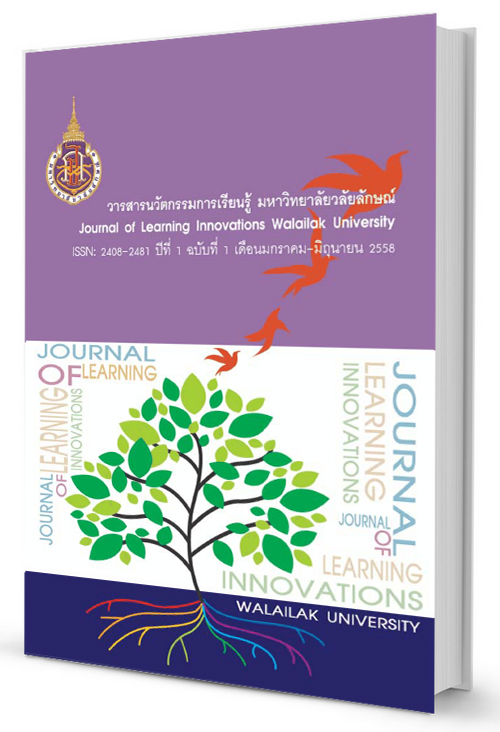Peace Education: Roles and Activities onConf lict Transformation
DOI:
https://doi.org/10.14456/jli.2015.5Keywords:
การเรียนสันติภาพศึกษา, ความขัดแย้ง, กระบวนการสันติภาพ, การแปรสภาพความขัดแย้ง, ภาคประชาสังคม, Peace Education, Conflict, Peace Processes, Conflict Transformation, Civil SocietyAbstract
Peace education on either primary school or high school curriculums are participation learning processes for building dialogue among students. The processes can build capacities and skills on tolerant and respected differences as well as empathy of the other in plural society. However, peace education can be the crucial mechanism on peace support, in case the schools are in area of violent conflict. Therefore, this paper aims to examine the roles of peace education in conflict transformation by studying the actual processes on peace education theories from theorists and practitioners as well as the experience of applying peace education in the case studies of countries in conflict such as Armenia and India. In addition, foreign experiences can be useful for Thai education in the face of current political conflict in Thai society consisting of conflict in terms of ideology in the deep south of Thailand.
References
บุญยิ่ง ประทุม. (17 กุมภาพันธ์ 2553). การศึกษาทศวรรษปฏิรูปที่ 2 กับหลักสูตร ท้องถิน. [เว็บบล็อก]. สืบค้นจาก https://www.thaihealth.or.th/blog/ myblog/topic/68/baocd 12/108/AII/479/ปฏิรูปการศึกษาทศวรรษ ที่+2+กับหลักสูตรท้องถิ่น
ราชบัณฑิตยสถาน. (มีนาคม 2533). กลาสนอสต์ (Glasnost) และเปเรสตรอยกา (Perestroika). จดหมายข่าวราขบัณฑิตยสถาน, 2(15). สืบค้นจาก https:// www.royin.go.th/th/knowledge/ detail.php?ID=719
สถานเอกอัคราซทูตไทยกรุงนิวเดลี. (2007). ระบบการศึกษาในอินเดีย. สืบค้นจาก https://www.thaiemb.org.in/ th/study/index_study.php
อภิญญา ดิสสสะมาน. (2552). การจัดการความขัดแย้งในสังคมที่ยืดเยื้อเปรียบเทียบ กรณีศรีสังกากับสามจังหวัดขายแดนใต้. สืบค้นจาก สถาบันพระปกเกล้า Website https://www.kpi.ac.th/kpith/ index.php?option=com_co ntent&task=view&id=765<emid=255
Abdullah Hasan. (2002, June). Minorities, education and language: The Case of Urdu. Economic and Political Weekly, 37(24), 2288-2292.
Berghof Foundaion. (2012). Berghof glossary on conflict transformation: 20 notions for heory and practice. Berlin, Germany: Berghof Foundation.
Berghof Foundation. (2014). Annual report 2013. Berlin, Germany: Berghof Foundation.
Central Intelligence Agency: CIA. (2014). The world factbook: India. Retrieved from https://www.cia.gov/library/publications/the- world-factbook/geos/in.html
Fisas, V. (2014). 2014 Yearbook of peace processes. SA, Spain: Romanya Vails.
Government of India. (1986). National Policy on Education. New Delhi. India: MFIRD.
Jeong, Flo-Won. (2000). Peace and conflict studies: An inroducion. Hants, England: Ashgate.
Harris, I. M. (2007). Peace educaion theory. Journal of Peace Educaion, 1(1), 5-20.
indiaonlinepages.com. (2015). Muslim Population in India. Retrieved from https://www.indiaonlinepages.com/population/muslim- population-in-india.html
Jager, U. (2014). Peace education and conflict transformation. Berlin, Germany: Berghof Foundation.
Lum. B. J. (2013). Peace education: Past, present, future. Journal of Peace Education, 10(2), 121-123. doi: 10.1080/17400201.2013. 821835.
Ministry of Law and Justice. (2007). The Constitution of India. Retrieved from https://lawmin.nic.in/coi/coiason29july08.pdf
National Council of Educational Research and Training: NCERT. (2005). Syllabus Eluman Ecology and Family SciencesiClasses XI-XII). Retrieved from https://www.ncert.nic.in/rightside/ links/pdf/ syllabus/syllabus/Syllabus.pdf
Nitithorn Thongthirakul. (2009). Crystallization of good practices and lessons learned on the promotion of human rights education in Thailand. Eluman Rights Education in Asian Schools, 12, 81-86.
Palandjian, G. (2012, December). Silenced voices: The unpoppular armenian perspective of the Karabakh conflict. Caucasus Edition: Journal of ConflictTransformation. Retrieved from https:// caucasusedition.net/analysis/silenced-voices-the-unpopular- armenian-perspective-of-the-karabakh-conflict-2/
Palandjian, G. (2013). Educaing peace: A case study of peace educaion curricula in Armenia. Washington, DC: IREX.
Prasad, S. N. (1998). Development of peace education in Indio (Since Independence). Peace Education Miniprints, No. 95. Malmo, Sweden: Lund University.
Sargsyan, A. H. (2013). No. 131: Nagorno-Karabakh: Obstacles to o negotiated settlement. Zurich, Switzerland: Center for Security Studies (CSS).
Saroj Pandey. (2000). Human rights education in schools: The Indian experience. Human Rights Education in Asian Schools, 8. Retrieved from https://www.hurights.or.jp/archives/ pdf/asia-s- ed/v08/l llndianExperience.pdf
Tint, B. S. & Prasad, G. K. (2007). Peace Education in India: Academics, Politics, and Peace. Peace Research :The Conodion Journal of Peace and Conflict Studies Economic Assistance, 39(1-2), 23-37.
Upadhyaya, R. (2014). Indio: Murder of northeastern man in New Delhi renews racism debate. New Delhi: International Bussiness Times. Retrieved from https://www.ibtimes.co.uk/india-murder- northeastern-man-delhi-renews-racism-debate-1845749
Downloads
How to Cite
Issue
Section
License
เนื้อหาและข้อมูลในบทความที่ลงตีพิมพ์ในวารสารนวัตกรรมการเรียนรู้ มหาวิทยาลัยวลัยลักษณ์ ถือเป็นข้อคิดเห็นและความรับผิดชอบของผู้เขียนบทความโดยตรง ซึ่งกองบรรณาธิการวารสาร ไม่จำเป็นต้องเห็นด้วย หรือร่วมรับผิดชอบใดๆ
บทความ ข้อมูล เนื้อหา รูปภาพ ฯลฯ ที่ได้รับการตีพิมพ์ในวารสารนวัตกรรมการเรียนรู้ มหาวิทยาลัยวลัยลักษณ์ ถือเป็นลิขสิทธิ์ของวารสารนวัตกรรมการเรียนรุ้ มหาวิทยาลัยวลัยลักษณ์ หากบุคคลหรือหน่วยงานใดต้องการนำทั้งหมดหรือส่วนหนึ่งส่วนใดไปเผยแพร่ต่อเพื่อกระทำการใดๆ จ้อต้องได้รับอนุญาตเป็นลายลักษณ์อักษรจากวารสารนวัตกรรมการเรียนรู้ มหาวิทยาลัยวลัยลักษณ์ก่อนเท่านั้น

